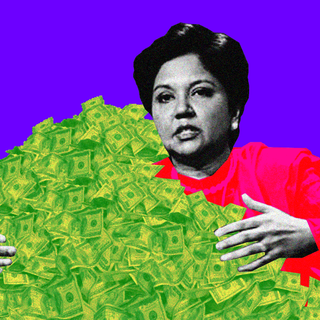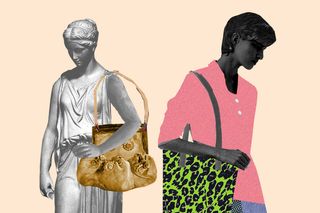
A History of the Handbag From a Practical Necessity to Creative Canvas
The handbag has always straddled the line between function and beauty. Its history shows how the two came together, making it a symbol of its wearer.

Once upon a time, the handbag was a gender-neutral necessity, not an accessory. In medieval Europe, pouches made of cloth and leather hung from a girdle belt tied at the waist — like charms in a bracelet. Their Indian relative, the potli bags,evenfind mention in Vedic texts, as they were used to carry herbs for Ayurveda treatments.
Then, around the 16th century, women’s skirts expanded to puffy, immense proportions, and the purse kept getting lost in spools of fabric. The answer was to hang the purses under skirts — an early version of pockets. But in the Renaissance period, when the dresses grew slender, it became a faux pas to have undulating lines of “pockets” peeping from within.
Thus, the earliest predecessor of the modern handbag — the “reticule” — was born. People satirically referred to it as a “ridicule” to mock its small size, but for women, it was an “indispensable” novelty that allowed them to display their personality, idea, status. “These early handbags were also daring… The idea of a woman parading her personal belongings in a visible pocket was an act akin to lifting her skirts and publicly revealing her underwear,” as writer Caroline Cox notes in Bags: An Illustrated History.
In some ways, thus, the handbag defied the idea of a “modest” woman. Psychologist Sigmund Freud argued that since purses were “sexually suggestive,” women who carried them were more cavalier with their sexuality.
Women’s fashion finally embraced handbags around the 20th century, as they came to symbolize the ultimate “ultra-feminine” accessory. On the other hand, men’s fashion moved towards pockets; the pocket as a site of utility aligned with masculinity.
Western concerns of being “vulgar” and “daring” were quickly dissipated once the handbags began to look “good”; their style, material, prices, and brands made them desirable.
In other words, it was only when handbags stopped being seen as functional and became “beautiful” that people saw them as the uncontested trope of femininity.
Manufacturers also quickly realized that they could make much more money by denying women pockets. “Valued at 8 billion dollars, the purse industry isn’t about to give women pockets and lose their highly profitable handbag business!” writer Laura Moffat commented.
***
But while the past of the handbag tells a tale of sexism, the present tells one of resistance.
“From chatelaine to reticule to designer bag, the handbag has always offered both freedom and yoke,” writer Julie Schulte summarizes the legacy. “It encapsulates a fact about its owner and reveals that fact as much as, or more than, it conceals her belongings.” The handbag thus emerged synonymous with a survival kit. More importantly, it became an essential facet of women’s identity.
Perhaps it’s why author David Dalton while describing icon Janis Joplin in 1972 in a biography, made space to describe the handbag and its 30 habitants. It was, as Dalton called, “awesome.”
Related on The Swaddle:
A Love Letter to Pre‑Loved, Budget‑Friendly Fashion
The handbag was a way to define and communicate identities to the world. Think Grace Kelly, Jane Birkin, or Diana, Princess of Wales, to realize how intricately handbags personify identity. Or the fact that Queen Elizabeth never steps out without her signature Launer handbag (she owns 200 of them). The desirability of the bags aside, they serve a royal purpose in sending secret signals to her staff.
Anything that attaches itself to identity also becomes a vehicle to freedom. Around the First World War, the handbag symbolized increased emancipation for women. “Women had their own cash and bank accounts and keys to their own property and cars — and they wanted the world to know it. What better reason to flaunt the fashionable clutch of the 1920s rather than having to burrow for necessities in hidden pockets beneath voluminous skirts?” noted writer Alexandra Shulman. Women carried their own money and possessions in these newly colonized sites, not relying on their husbands. As women became increasingly employed, their handbags responded to their growing mobility and practical needs.
The classic handbag, the clutch, the satchel, shoulder bag, briefcases — all responded to a desire and self-sufficiency. “These changes in the bag itself also marked a change in the idea of a woman’s handbag — it became something entirely her own,” Anna Johnson wrote in Handbags: The Power of the Purse.
For an accessory, then, the handbag does a lot. It adapts to gender, religious, environmental concerns while being an intimate space of being. As writer Kimberly Chrisman-Campbell said: “The purse has always been political, a reflection of changing economic realities and gender roles.”
On the shoulders, tucked under the arms, hanging on the elbow — the bag became an important symbol of gender nonconformity around the 1960s. “The handbag is no longer from another world, the world of ‘woman’ or ‘girlfriend,’ but simply a beautiful and practical thing without gender,” Ethan Price argued in i-D.
Thus, people began using handbags to expand the space afforded to them. Think of the highly functional and essential “mom purse,” which takes pride in storing all practical things for every outing. Wilcox likens this claim to growing space as a reflection of one’s personal growth. “In each stage of her life, women put inside all the things she thinks are necessary to carry,” she argues.
Desire and individuality took as much precedence outside as they did inside the bags. In a paper, researcher Nanette Marguerite Nel equates the private with the “inner self” and the bag’s exterior with the “projected self.” The handbag then contributes to a more authentic representation of oneself. Moreover, carrying the private in the public domain promised freedom; the more people could carry, the more freedom they had in navigating public places. The general clutter of a bag — loose change, hair ties, rogue pens — thus become tools to solve the eternal mysteries of the world.
“It’s only when you leave home that you decide what is important to you – those things you choose to carry with you define you,” Dr. Lucia Savi, curator of a bags exhibition at the Victoria and Albert Museum, told The Guardian.
The handbag has a rich inner life. If freedom occupies one pocket, restrictions take precedence in another. But the victory lies in the adaptability and survival of the handbag as people write and rewrite its legacy. It is functional, desirable, and defiant.
Most importantly, it is a canvas to tell people who we are or want to be.
Saumya Kalia is an Associate Editor at The Swaddle. Her journalism and writing explore issues of social justice, digital sub-cultures, media ecosystem, literature, and memory as they cut across socio-cultural periods. You can reach her at @Saumya_Kalia.
Related


How Cities Are Designed to Restrict Women’s Access to Drinking Culture
